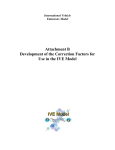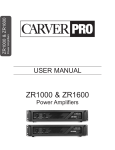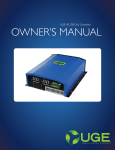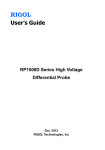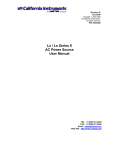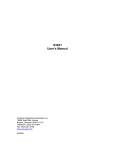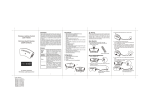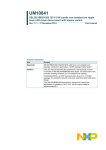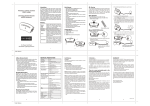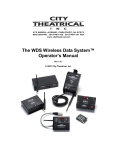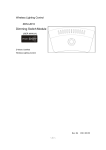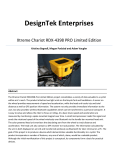Download LCR Elite1
Transcript
LCR Elite1 User Manual LCR Elite1 User Manual - ver 1.0 Notices The information contained in this document is provided “as is”, and is subject to change, without notice, in future editions. This document contains proprietary information that is protected by copyright. All rights are reserved. No part of this document may be photocopied, reproduced, or translated to another language without the prior agreement and written consent from LCR Research Ltd. © LCR Research Ltd. 2015 Warranty LCR Research warrants this product to be free from defects in materials and workmanship for a period of one (1) year from the shipment date. LCR Research warrants the following items for ninety (90) days from the date of shipment: rechargeable batteries, gold plated tips and documentation. During the warranty period, LCR Research will, at its option, either repair or replace products that prove to be defective. For warranty service or repair, this product must be returned to a service facility designated by LCR Research. The buyer shall prepay shipping charges to LCR Research, and LCR Research shall pay shipping charges to return the product to the buyer. However, the Buyer shall pay all shipping charges, duties, and taxes for products returned to LCR Research from another country. Repaired or replaced products are warranted for the balance of the original warranty period. Limitation of Warranty This warranty does not cover normal wear and tear and scratches on surface or screen. This warranty does not cover physical damage to the screen, switch and/or button; electrical damage of the product due to high voltage or improper battery type. This warranty does not cover to any product from which the serial number has been removed or that has been damaged or rendered defective resulting from improper or inadequate maintenance by the Buyer, software, interfacing or parts not supplied by LCR Research, unauthorized modification or misuse, operation outside the usage parameters stated in the user documentation, or improper site preparation or maintenance. LCR Research specifically disclaims no other warranty is expressed or implied, including the implied warranties of merchantability or fitness for a particular purpose. LCR Research shall not be liable for errors or for incidental or consequential damages in connection with the furnishing, use, or performance of this document or of any information contained herein. Exclusive Remedies The remedies provided herein are the Buyer’s sole and exclusive remedies. LCR Research shall not be liable for any direct, indirect, special, incidental, or consequential damages, whether based on contract, tort, or any other legal theory. Such excluded damages shall include, but are not limited to: costs of removal and installation, losses sustained as the result of injury to any person, or damage to property. LCR Elite1 User Manual - ver 1.0 Safety Notices CAUTION Caution must be observed to avoid minor injury to yourself or damage to the product or other property. WARNING Warnings must be followed carefully to avoid personal injury, death or damage to the product or other property. Safety Considerations Read the information below before using this metre. This metre is intended for use by qualified personnel who recognize shock hazards and are familiar with the safety precautions required to avoid possible injury. The following general safety precautions must be observed during all phases of operation, service, and repair of this metre. Failure to comply with these precautions or with specific warnings elsewhere in this manual violates safety standards for design, manufacture, and intended use of the metre. LCR Research assumes no liability for the customer’s failure to comply with these requirements. CAUTION • • • • Disconnect circuit power and discharge all high-voltage capacitors before testing. When measuring in-circuit components, first de-energize the circuits before connecting them to the test tips. The battery must be charged by a computer USB port or a USB power adapter that provides output voltage DC 5V ± 5%. This metre is for indoor use at altitudes of up to 2000 metres. WARNING • • • • • • • • • • Use this metre only as specified in this manual; otherwise, the protection provided by the metre may be impaired. Do not use the metre if it is damaged. Before you use the metre, inspect the case. Look for cracks or missing plastic. Inspect the test tip sleeves for damaged insulation or exposed metal. Check the test tips for continuity. Replace damaged test tip sleeves before you use the metre. Do not touch exposed metal in measurement. Keep your fingers on insulated test tip sleeves. Do not use the metre if it operates abnormally. Do not operate the metre around explosive gas, vapor, or in wet environments. Never use the metre in wet conditions or when there is water on the surface. If the metre is wet, ensure that the metre is dried only by trained personnel. When servicing the metre, use only the specified replacement parts. Do not attempt to replace the internal lithium-ion polymer battery yourself. You may damage the battery and/ or board, which could cause overheating and injury. The battery should be replaced only by a LCR Research Authorized Service Provider, and must be recycled or disposed of separately from household waste. Do not incinerate the battery. Do not use damaged cables or chargers, or charge when moisture is present. It can cause fire, electric shock, injury, or damage to the product or other property. LCR Elite1 User Manual - ver 1.0 Contents 1. Overview Product Introduction . . . . . . . . . . . . . . . . . . . . . . . . . . . . . . . . . . . . . . . . . . . . . . . . . . . . . . . . . . . . . 1 Features and Functions .. . . . . . . . . . . . . . . . . . . . . . . . . . . . . . . . . . . . . . . . . . . . . . . . . . . . . . . . . . 1 Turn On the Metre . . . . . . . . . . . . . . . . . . . . . . . . . . . . . . . . . . . . . . . . . . . . . . . . . . . . . . . . . . . . . . . . 2 Power Off . . . . . . . . . . . . . . . . . . . . . . . . . . . . . . . . . . . . . . . . . . . . . . . . . . . . . . . . . . . . . . . . . . . . . . . . . 2 Charging the Battery . . . . . . . . . . . . . . . . . . . . . . . . . . . . . . . . . . . . . . . . . . . . . . . . . . . . . . . . . . . . . 2 Battery Level Indicator . . . . . . . . . . . . . . . . . . . . . . . . . . . . . . . . . . . . . . . . . . . . . . . . . . . . . . . . . . . 2 Display Screen . . . . . . . . . . . . . . . . . . . . . . . . . . . . . . . . . . . . . . . . . . . . . . . . . . . . . . . . . . . . . . . . . . . . 3 General Display Indicators . . . . . . . . . . . . . . . . . . . . . . . . . . . . . . . . . . . . . . . . . . . . . . . . . . . . . 3 Measurement Units . . . . . . . . . . . . . . . . . . . . . . . . . . . . . . . . . . . . . . . . . . . . . . . . . . . . . . . . . . . . 4 Cleaning the Metre . . . . . . . . . . . . . . . . . . . . . . . . . . . . . . . . . . . . . . . . . . . . . . . . . . . . . . . . . . . . . . . 5 2. Making Measurements Selecting the Measurement Modes .. . . . . . . . . . . . . . . . . . . . . . . . . . . . . . . . . . . . . . . . . . . . . 6 Selecting the Testing Frequency .. . . . . . . . . . . . . . . . . . . . . . . . . . . . . . . . . . . . . . . . . . . . . . . . 7 Selecting the Series/Parallel Circuit Mode .. . . . . . . . . . . . . . . . . . . . . . . . . . . . . . . . . . . . . . 8 Shortcut to the Default Mode .. . . . . . . . . . . . . . . . . . . . . . . . . . . . . . . . . . . . . . . . . . . . . . . . . . . 8 3. Characteristics and Specifications Product Characteristics .. . . . . . . . . . . . . . . . . . . . . . . . . . . . . . . . . . . . . . . . . . . . . . . . . . . . . . . . . . 9 Electrical Specifications . . . . . . . . . . . . . . . . . . . . . . . . . . . . . . . . . . . . . . . . . . . . . . . . . . . . . . . . . . 9 Testing Signal Specifications . . . . . . . . . . . . . . . . . . . . . . . . . . . . . . . . . . . . . . . . . . . . . . . . . . 9 Typical Offsets . . . . . . . . . . . . . . . . . . . . . . . . . . . . . . . . . . . . . . . . . . . . . . . . . . . . . . . . . . . . . . . 10 Measurement Ranges and Optimal Testing Frequency .. . . . . . . . . . . . . . . . . . . 10 Accuracy Specifications . . . . . . . . . . . . . . . . . . . . . . . . . . . . . . . . . . . . . . . . . . . . . . . . . . . . . . 11 LCR Elite1 User Manual - ver 1.0 1. Overview This chapter provides the basic operation procedures and describes names and functions on the screen display. Product Introduction LCR Elite1 (“the metre”) is a portable impedance measuring device for incoming inspection of components, quality control, and laboratory use. It is capable of measuring resistance, capacitance or inductance with 3 test frequencies (100Hz, 1kHz and 10kHz). It has a basic accuracy better than 0.5% for resistance and 1% for capacitance and inductance measurements. The metre has a pair of gold plated tips that can pick the SMD components with size down to 0201. The parasitic parameters of its probes are small and very predictable thanks to its unique mechanical design. It significantly reduces the probability of measurement errors related to setup (such as wires, probes, tips). Features and Functions Navigation button OLED display Tweezers type test probes Replaceable gold plated tips Micro-B USB Figure 1-1: LCR Elite1 overview 1 LCR Elite1 User Manual - ver 1.0 Turn On the Metre To power on the metre, press the navigation button once. The metre powers up with the most recently selected measurement function. Power Off The metre powers off automatically if neither a measurement is performed nor the navigation button is clicked for approximately 60 seconds. To manually power off metre - press and hold button until “TURNING OFF” message appears on screen (Figure 1-2). Figure 1-2: Power off message Note If test frequency is manually set to 10 kHz, automatic power off may take longer to occur or not occur at all. This is due to the metre being more sensitive at 10 kHz. It may see parasitic values and keep measuring even when the tips are open. Charging the Battery The metre is powered by an internal, lithium-ion polymer rechargeable battery. It can be charged by connecting to a computer USB port using a standard micro-B USB cable or, by using an USB power adapter. The USB power adapter should have output voltage 5V +/- 5% with output current 100 mA or greater. The USB cable and power adapter are available separately. (Figure 1-3) Figure 1-3: Charge using power adapter or computer Battery Level Indicator The battery icon in the bottom-right corner shows the battery level or charging status. When the battery icon becomes hollow, it indicates that the battery remaining capacity is low and it should be recharged. The warning appears when the battery capacity is about 95% depleted. The unit is still operational for a while; however the battery should be recharged as soon as possible. (Figure 1-4) Full capacity Empty battery CAUTION Figure 1-4: Battery charge icons Rechargeable batteries have a limited number of charge cycles and may eventually need to be replaced. The metre battery isn’t user replaceable; it can be replaced only by a LCR Research Authorized Service Provider. 2 LCR Elite1 User Manual - ver 1.0 The Navigation Button The navigation button is used to select different functions by single clicking, double clicking or triple clicking the navigation button. Please read the Selecting the Measurement Modes chapter on page 6 for detailed instructions. Single click to select measurements. Double click to select testing frequencies. Triple click to select series/parallel circuit modes. The navigation button can be used for shortcut operation as well. When it is pressed down for approximately 2 seconds, the metre goes to the default mode no matter which mode it is currently in. For detailed information, please go to page 8: Shortcut to the Default Mode. Display Screen This section describes the names and functions of parts on the metre screen. General Display Indicators The general display indicators of the metre are described in the table below. Each display indicator is described in Table 1-1. Select the respective “Learn more” pages in Table 1-1 for more information on each indicator. Test frequency Test frequency mode Test mode Primary display Secondary display Circuit mode Auto circuit mode selection Battery indicator Figure 1-5: Measurement display 3 LCR Elite1 User Manual - ver 1.0 Measurement Units The available signs and notations for each measurement function in the metre are described in Table 1-1. Table 1-1 General Display Indicators Indicator Description A Auto mode indicator R Resistance measurement indicator L Inductance measurement indicator C Capacitance measurement indicator Rs Series equivalent resistance Rp Parallel equivalent resistance AF Auto testing frequency selection MF Manual test frequency selection 100 Hz Testing frequency at 100 Hz 1 kHz Testing frequency at 1 kHz 10 kHz Testing frequency at 10 kHz AC Auto circuit mode selection Parallel circuit mode indicator Series circuit mode indicator Battery level indicator Learn more on: Page 6 Page 6 Page 6 Page 6 Page 7 Page 7 Page 7 Page 7 Page 7 Page 8 Page 8 Page 8 Page 2 The units listed below are applicable to the primary display measurements of the metre. Table 1-2 Measurement Units Display Legend Description M mega 1E+06 (1000000) K m u n p uH, mH, H pF, nF, uF, mF mΩ, Ω, kΩ, MΩ Hz, kHz 4 kilo 1E+03 (1000) milli 1E–03 (0.001) micro 1E–06 (0.000001) nano 1E–09 (0.000000001) pico 1E–12 (0.000000000001) Henry, units for inductance measurement Farad, units for capacitance measurement Ohm, units for resistance and impedance measurement Hertz, units for frequency measurement LCR Elite1 User Manual - ver 1.0 Cleaning the Metre WARNING To avoid electrical shock or damage to the metre, always keep the insides of the casing dry. Dirt or moisture on the tips can affect measurement accuracy. Follow the steps below to clean the tips and case. 1. Shake out any dirt that may be on the tips. 2. Wipe the tips with a clean swab dipped in alcohol. 3. Wipe the case with a damp cloth and mild detergent. Note Do not use abrasives or solvents when clean the metre. 5 LCR Elite1 User Manual - ver 1.0 2. Making Measurements Selecting the Measurement Modes Single click the “navigation” button to select the measurement mode. Four measurement modes can be selected as displayed in the flow chart below. Table 2-1 Measurement Mode Selection Legend Function Description A Auto mode Automatically identify the component type in the primary R L C Resistance mode Inductance mode Capacitance mode display (L, C, or R) Measure resistance Measure inductance Measure capacitance Figure 2-1 shows how the measurement functions are switched when the navigation button is single clicked. Figure 2-1: Measurement mode selection WARNING To avoid electrical hazards and possible damage to the metre or to the equipment under test, always discharge the capacitor to be tested before measuring. For in circuit measurement, always disconnect circuit power and discharge all high-voltage capacitors before testing. 6 LCR Elite1 User Manual - ver 1.0 Note In auto mode, the metre identifies L, C, and R measurements automatically according to the angle of impedance detected in the DUT. See Table 2-2 for the phase angle rules. Table 2-2 Auto Mode Phase Angle Rules Phase angle Primary display Secondary display |Q| < 0.15 R Q >= +0.15 L Q < -0.15 C Rs or Rp (depends on user settings) Rs or Rp (depends on user settings) Note When auto mode is selected by single clicking the navigation button, the testing frequency and series/parallel circuit mode stay unchanged. To change them separately, please refer page 7: Selecting the Testing Frequency and page 8: Selecting the Series/Parallel Circuit Mode. A shortcut is available to quickly switch to the default mode (auto mode with auto testing frequency and auto circuit mode), please refer page 8: Shortcut to the Default Mode. Selecting the Testing Frequency AF Double click the “navigation” button to select the testing frequency. Four testing frequencies can be selected as displayed in the flow chart below. Table 2-3 Testing Frequency Selection Legend Description AF Auto testing frequency 100 Hz 1 kHz 10 kHz 100 Hz testing frequency 1 kHz testing frequency 10 kHz testing frequency Figure 2-2: Selecting testing frequency Figure 2-2 shows how the test frequencies are switched when the navigation button is double clicked. Note The metre is capable of using auto frequency to measure capacitance approximately greater than 3 pF and inductance approximately greater than 10 uH. To measure capacitance or inductance out of this range, please select the proper testing frequency manually according to Table 3-4: Measurement Ranges and Optimal Testing Frequency on page 10. 7 LCR Elite1 User Manual - ver 1.0 Selecting the Series/Parallel Circuit Mode Triple click the “navigation” button to select the circuit mode for the secondary display. Three circuit modes can be selected as displayed in the flow chart to the right. AC Table 2-4 Circuit Mode Selection Legend Description AC Auto circuit mode Parallel circuit mode Series circuit mode If the auto circuit mode is selected, series or parallel circuit mode will be automatically identified. See Table 2-5 for the series/parallel rules used. Figure 2-3: Selecting circuit mode Table 2-5 Auto Circuit Mode Series/Parallel Rules for Capacitance Measurements Capacitance range C < 400 pF Parallel circuit diagram (Rp) C >= 400 pF Serial circuit diagram (Rs) Shortcut to the Default Mode The metre provides shortcut to let the user go to default mode quickly. As long as the navigation button is pressed down for approximately 2 seconds, it goes to the default mode no matter which mode it is currently in. In the default mode, the metre automatically selects: • • • An appropriate measurement in the primary display (L, C, or R) and secondary display (Rs or Rp). An appropriate testing frequency. An appropriate circuit mode (series or parallel). Follow the following steps to reset to the default mode: 1. Press down the navigation button. 2. In approximately 2 seconds, the Resetting to default prompts will be shown on the display as Figure 2-4 shows. 3. Release the navigation button to bring the metre to default mode. 8 Figure 2-4: Resetting to default LCR Elite1 User Manual - ver 1.0 3. Characteristics and Specifications Product Characteristics Table 3-1 Product Characteristics Dimensions (L x W x H) 151 x 19 x 14.5mm Weight 30 grams Display 0.91-inch, 128x32 OLED display Battery 3.7V 150 mAH internal lithium-ion polymer battery Battery life 1 day in typical measurement (1) Charging source USB port USB power adapter (output voltage DC 5V ± 5%) Charging time 2.5 hours typical Measurement rate 1 time/second typical Operating environment Operating temperature from -10°C to 50°C, 0% to 80% RH Full accuracy up to 80% RH for temperature 23°C ± 3°C Altitude up to 2000 m Storage compliance Safety and EMC compliance -20°C to 60°C, 0% to 80% RH IEC61000-4-2 - ESD (4 kV Contact, 8 kV Air) EN 61000-4-3 - Radiated Immunity IEC61000-4-8 - Magnetic Field Immunity FCC15/EN 55011/ICES-003 - Class A, Radiated Emisisons Calibration cycle FCC15 Class A Conducted Emissions 1 Year Note (1) Battery life varies by use, configuration, and many other factors. Actual results may vary. Electrical Specifications Testing Signal Specifications Table 3-2 Testing Signal Specifications Testing frequency 100Hz, 1kHz, 10kHz Testing signal level 0.45Vrms Source impedance 100Ω ± 1% 9 LCR Elite1 User Manual - ver 1.0 Typical Offsets Table 3-3 Typical Offsets Resistance offset (1) Capacitance offset (2) 25 mΩ 0.25 pF for 0201 size 0.21 pF for 0402 size 0.18 pF for 0603 size 0.16 pF for 0805 size Inductance offset (3) 0.15 pF for 1206 size 150 nH Notes (1) There is some small resistance offset due to the resistance of the tips, and the contact resistance between the tips and the component being measured. Typical offset value is approximately 25 mΩ and may increase if the gold on the tips wears out. It is recommended that the user performs offset measurements before making precision measurements, and use such offset value to calculate the actual resistance. (2) There is some small capacitance offset due to the capacitance between tips. The offset depends on the distance between the tips (i.e. measured component size). It is recommended that the user performs offset measurements before making precision measurements, and use such offset value to calculate the actual capacitance. (3) There is some small inductance offset due to the inductance on tips. Typical offset value is approximately 150nH. It is recommended that the user performs offset measurements before making precision measurements, and use such offset value to calculate the actual inductance. Measurement Ranges and Optimal Testing Frequency Table 3-4 Measurement Ranges and Optimal Testing Frequency Parameter Measurement range Optimal testing frequency Resistance 25 mΩ to 10 MΩ 1 kHz Capacitance 0.3 pF to 30 nF 10 kHz Inductance 10 30 nF to 20 uF 1 kHz 20 uF to 500 uF 100 nH to 10 mH 100 Hz 10 kHz 10 mH to 500 mH 1 kHz 500 mH to 1 H 100 Hz LCR Elite1 User Manual - ver 1.0 Accuracy Specifications (1) Table 3-5 Accuracy Specifications Resistance 25 mΩ - 1 MΩ 0.5 % + 20 mΩ 1 MΩ - 2 MΩ 2.0 % 2 MΩ - 10 MΩ 5.0 % Inductance 100 nH - 1 H 1.0 % + 50 nH (2) Capacitance 0.3 pF - 500 uF 1.0 % + 0.2 pF Table 3-6 Resistance Resolution Range Resolution 100 mΩ 0.01 mΩ 1Ω 0.1 mΩ 10 Ω 1 mΩ 100 Ω 10 mΩ 1 kΩ 100 mΩ 10 kΩ 1Ω 100 kΩ 10 Ω 1 MΩ 100 Ω 10 MΩ 1 kΩ Table 3-7 Capacitance Resolution Range Resolution 10 pF 0.001 pF 100 pF 0.01 pF 1 nF 0.1 pF 10 nF 1 pF 100 nF 10 pF 1 uF 100 pF 10 uF 100 uF 500 uF 1 nF 10 nF 100 nF Table 3-8 Inductance Resolution Range Resolution 1 uH 0.1 nH 10 uH 1 nH 100 uH 10 nH 1 mH 100 nH 10 mH 1 uH 100 mH 10 uH 1H 100 uH Note (1) Accuracy is specified at optimum test frequency after subtract the offset resistance, inductance or capacitance. (2) The accuracy for the ceramic capacitor will be influenced depending on the dielectric constant (K) of the material used to make the ceramic capacitor. 11 LCR Elite1 User Manual - ver 1.0















